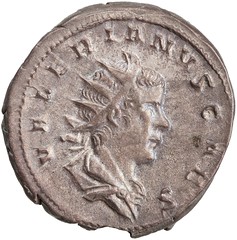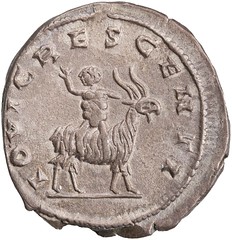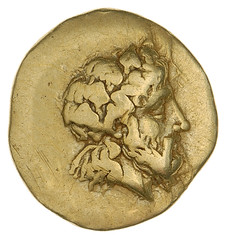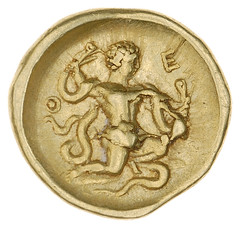
PREV ARTICLE
NEXT ARTICLE
FULL ISSUE
PREV FULL ISSUE
CHILD-GODS: WEE DEITIES ON COINSAustin Andrews of the American Numismatic Society published a Pocket Change blog article on child-gods on coinage. Here's an excerpt - see the complete article online. -Editor
Infanthood is one of the few universal conditions that every adult has once experienced, which they—other than subconsciously—cannot explicitly recall. Within this known ignorance, there is a fascinating projection of humanity onto the divine, in terms of religious sentiment and human psychology. If the gods look and act like people, with their unique personalities and eccentricities, then, according to some ancient accounts, they must also share in infancy and childhood. Across the ancient Mediterranean, there were a number of anthropomorphic divinities who appeared on coins and on other visual media in the form of very young humans as their conventional iconography. Other gods manifested in this way in only certain instances, usually engaging a particular type of myth comparable to comic book The exploits of child-gods often exhibited the realms of their authorities; visual representations provide a snapshot of these stories. Such evocative narratives and images demonstrate various ancient conceptions of the divine and what issuing authorities sought to evoke with such figures on their coinages. To survey these ideas, let us turn to three examples, reviewing infant representations of the gods known as Zeus, Herakles, and Eros in Greek, or in Latin as Jupiter, Hercules, and Cupid.
Zeus-Jupiter
A baby is observable on the reverse of the above antoninianus minted in the middle of the third century CE (Fig. 1). He wears a bunched garment, rides a goat side-saddle, and enthusiastically raises his outstretched right arm at the elbow. In other instances of this type, the figure seems to grasp one of the goat's horns to steady himself. In this specimen, he may be holding something in front of his chest, but this is otherwise unclear. He glances playfully behind his livestock steed. The goat strides atop a simple groundline, her head raised and horns upright. If the image did not make it clear to the viewer as to who is being represented, the text of the Latin inscription, IOVI CRESCENTI, settles that fact, celebrating
In myth, Jupiter's infancy was an escape from a fraught scenario. Hesiod's Theogony (c. 8th c. BCE), a title that could also be rendered in English as
The obverse of this coin features the radiate Valerian II, the son of the Roman emperor Gallienus, co-ruler with Valerian I. Valerian II was briefly elevated to Caesar, or junior emperor in this period, as a young teenager in 256 CE. Nicholas M. McQ. Holmes in the Numismatic Chronicle, Vol. 177 (2017) noted that the reverse type is
Herakles-Hercules Figure 2. Electrum diobol, Thebes, 4th c. BCE. Obverse: Dionysus head. Reverse: Herakles as infant strangling serpents (ANS 1967.152.253). The infant Herakles is shown on the reverse of the above electrum coin from Thebes, minted in the fourth century BCE (Fig. 2), with similar types found on other Theban silver staters. A pervasive narrative across the ancient Mediterranean describes a divine-hero conquering a serpentine monster, often representing darkness, chaos, and evil simultaneously. Notable among these stories are Apollo slaying Python and Zeus slaying Typhon. One story that riffs on this narrative type is associated with the infant Herakles encountering two malicious snakes and strangling them with his clenched babyfists. Some sources present these snakes as having been intentionally sent in wrath by Hera, angered at the product of her husband's extramarital dalliances.
To read the complete article, see:
Wayne Homren, Editor The Numismatic Bibliomania Society is a non-profit organization promoting numismatic literature. See our web site at coinbooks.org. To submit items for publication in The E-Sylum, write to the Editor at this address: whomren@gmail.com To subscribe go to: https://my.binhost.com/lists/listinfo/esylum All Rights Reserved. NBS Home Page Contact the NBS webmaster 
|




